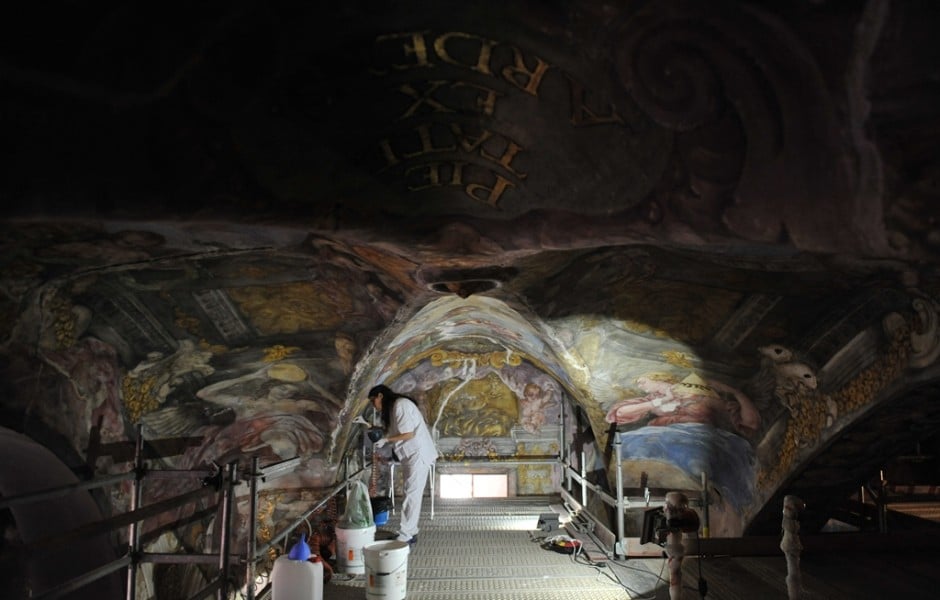The Baroque frescoes painted by Dionís Vidal at San Nicolás Church at the end of the 17th century have recovered their former pictorial glory, thanks to the restoration project carried out jointly by the Universitat Politècnica de València and the Archbishopric of the city, with the support of the Hortensia Herrero Foundation.
These frescoes are one of the assets of greater artistic and cultural interest of the Valencian Community. The agreement to undertake their restoration was signed at the end of last year, and the first results of the work developed to date have been presented today, Friday.
The project began with a first phase of diagnosis, which analysed the state of conservation of the frescoes and the rest of the ornamentation of the nave of the church. In this document, the specialists spoke of a “worrying deterioration as a whole”: the paintings were suffering from a generalised darkening of the surface and had part of their polychromy altered, whitish areas and irregular spots.
“A large part of the frescoes was subject to different repaintings, with the consequent accumulation of waxes and proteins. In some areas that have been already worked upon, there are repaintings that cover up to 80 % of the pictorial surface. They also suffered problems of efflorescence, migration of salts, etc. All this led to a stratification of materials that disfigure and completely cover the original polychromy,” José Luis Regidor says, a researcher at the UPV and responsible for the restoration team of the project.
Now, these first months of work have led to the discovery of the original work by Dionis Vidal, “frescoes that stand out for their high pictorial beauty and technical quality,” Pilar Roig says, a researcher at the Instituto de Restauración del Patrimonio of the UPV and the director of the project.
Roig also highlights the discovery of how Vidal, a disciple of Antonio Palomino, managed to capture the iconographic program of his master in the frescoes of San Nicolás. “Dionis Vidal strictly complies with the guidelines that Palomino depicted in his pictorial treatise and optical scale; the allegories, the symbology… everything is perfectly reflected in these paintings,” Pillar Roig explains.
Another of the milestones is located in the gable wall where Dionis Vidal, according to Palomino’s treatise, painted the portrait of Callixtus III, “which may have disappeared when the vision of the neo-Gothic rose window from inside the temple was recovered in subsequent times. The elimination of the repaintings has confirmed the existence of the original painting on that cropped area, in particular, in the figure of Saint Luke the Evangelist and in the angels and the papal tiara. As soon as you discover the original, you begin to unveil its history, how it was painted,” Roig says.
Cleaning bacteria, ultraviolet and microemulsions
In the execution of the project, researchers of the UPV are using advanced techniques of restoration, including the use of bacteria that are “taught”, in the laboratory, to clean the works of art fast and without impact on the painting; ultraviolet and infrared rays that allow to track the presence of repaintings; stratigraphy to see the accumulated layers of paint and matter; microemulsions and chelating gels, among others.
Project and team
The project of the UPV, the Hortensia Herrero Foundation and the Archbishopric of Valencia at San Nicolás Church encompasses four actions: consolidation of the support and the pictorial layer (crack and fissure sealing, microanchoring, application of binders…); cleaning (elimination of dust, adhered materials, insoluble salts…); treatment of gaps and aesthetical reintegration (volumetric reconstruction in carvings and angels, chromatic reintegration of gaps in painting and stuccos…), and support work (monitoring and control of the restoration).
Almost 30 people from the Instituto Universitario de Restauración del Patrimonio of the UPV form the interdisciplinary team that participates in this project, with a budget of around EUR 1,000,000. The works are intended to be completed in the autumn of 2015.
Architectural intervention
Along with the pictorial restoration process, the architectural strengthening of the temple in the covering points, the structure and some parts of the outside of the church is carried out. These works, conducted by the architect Carlos Campos, are borne by the EMR company (Estudio Métodos de la Restauración).
At present, the architectural works run in parallel with the pictorial restoration, so as to ensure the stability of the structures of the building, as well as the tightness of its coverings. “Both of these objectives are addressed by removing the current coverage of tile, for its restoration and subsequent reinstallation, as well as by the sealing of cracks and fissures that the vaulted surfaces may have, mainly in those points in which the coating of plaster and lime stucco made in the 17th century is present both on the inside and on the outside of the vaults,” Carlos Campos explains.

